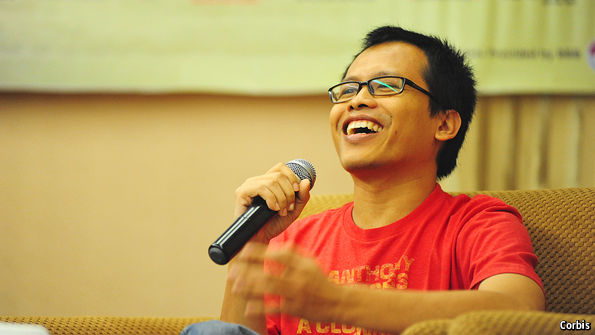
MASSIVE, chaotic, endless and, despite it all, also charming, Jakarta can seem less a city than some sort of organic life form inexorably consuming north-western Java. More people live in greater Jakarta than in Australia; its residents send out more tweets than those in any other city. Yet millions of Jakartans also live in slums with pirated electricity and no running water. Traffic clogs the streets from dawn until well after nightfall—kita tua di jalan (“We grow old in the streets”), complain the city’s eternally harried drivers—and people from every corner of Indonesia cram into every available corner of the city.
Eka Kurniawan, a young novelist, lives on the outskirts with his wife and daughter. When he sits down for a meeting at one of central Jakarta’s many shopping malls at 4.30pm, he says traffic will make it impossible for him to get back home before 10. Mr Eka may well be glad of the chance to sit still for a while. In the past few months he has appeared at book festivals in Melbourne, Brisbane, Brooklyn and Frankfurt—where Indonesia was the national guest of honour. Last year his American publisher, New Directions, whisked him around the country on a six-city book tour. Benedict Anderson of Cornell University, a luminary of South-East Asian studies who has recently died, called him “Indonesia’s most original living writer of novels and short stories”, and proclaimed him a successor to Pramoedya Ananta Toer, author of the social-realist “Buru Quartet”, and the man many consider to be Indonesia’s greatest-ever novelist.
Now 40, Mr Eka has published four books of short stories and three novels, only two of which have so far been translated into English: “Beauty is a Wound” (New Directions), which is being published in 27 languages and was included in eight international lists of best books of 2015, and “Man Tiger” (Verso), which has been nominated for the 2016 Man Booker International prize. The English-language rights to his third novel, “Love and Vengeance”, have recently been acquired by New Directions and Pushkin Press; publication is set for 2017.
If Mr Eka feels burdened by other people’s expectations, he does not show it. Small, slight and bespectacled, with a thoughtful elfin manner and a ready grin, he looks perhaps half his age, and chats freely and easily, without any apparent writerly agony. Mr Eka is Sundanese, and grew up in a small town in West Java which he used in “Beauty” as a model for Halimunda, the fictional setting that acts, as in William Faulkner’s novels, as a prism that filters and refracts Indonesia’s history. For a time he ran a souvenir shop, like Kliwon, the determined, sweet, relentlessly level-headed rebel in “Beauty”.
When not working on novels Mr Eka blogs and writes for television—“soap operas, and whatever else they order from me”. Like many writers, he says, “I always think about doing something else. But in the end I sit down and write again.” And again and again: he has a book called “O”—a fable, he says, modelled on George Orwell’s “Animal Farm”—coming out later this year in Indonesian.
The two books available in English are strikingly different. “Beauty is a Wound” is a sprawling work—seen through the eyes of Halimunda’s gangsters, rebels, prostitutes and gravediggers—that obliquely covers the history of Indonesia from the late colonial period onwards, through the 31-year rule of Indonesia’s second president, Suharto. Its opening line is hard to match: “One afternoon on a weekend in March, Dewi Ayu rose from her grave after being dead for 21 years.” The author said he spent much of his youth reading sastra picisan—pulp fiction filled with sex and violence, and his work has plenty of both.
Mr Eka bristles at the suggestion that “Beauty” is fictionalised history: “I tried to make it a joke about a historical novel,” he says, “and the joke is that you can’t have a historical novel.” “Beauty” is not about Indonesian history; it is about characters buffeted by that history. In its scope and seamless weaving of the fantastical and the quotidian, it owes a hefty debt to Gabriel García Márquez, though Mr Eka’s magical realism is much earthier and less lyrical than his Latin American predecessor’s (in a nifty bit of irony, the only character able consistently to use magic to his advantage is Kliwon, a communist who disavows religion and superstition).
The second book, “Man Tiger”, is slimmer and a quicker read—a murder mystery of sorts, though the first sentence reveals both murderer and victim. Even the motive is no mystery. Yet it is a testament to Mr Eka’s gift as a storyteller, particularly his skill at ratcheting up and tactically releasing tension, that he keeps readers enthralled nonetheless. Margio, the protagonist, is a sort of Javanese Raskolnikov (Dostoyevsky’s protagonist in “Crime and Punishment”), though technically it is not he, but a white tiger living inside him, that does the killing. Mr Eka calls this his most personal book: “There is a parallelism between me and Margio…In Indonesia we keep our anger, we repress our anger, but in the end…the tiger comes out, and we don’t know how to handle this tiger.”
Such concern for the personal rather than the political, and his rejection of conventional realism in “Beauty”, exorcises the ghost of Pramoedya’s socialist-realism. Writing towards the end of colonialism, Pramoedya wanted most of all to give Indonesians an identity. If he was the nation’s Zola, Mr Eka is shaping up to be its Murakami: approaching social concerns at an angle rather than head-on, with hefty doses of surrealism and wry humour.